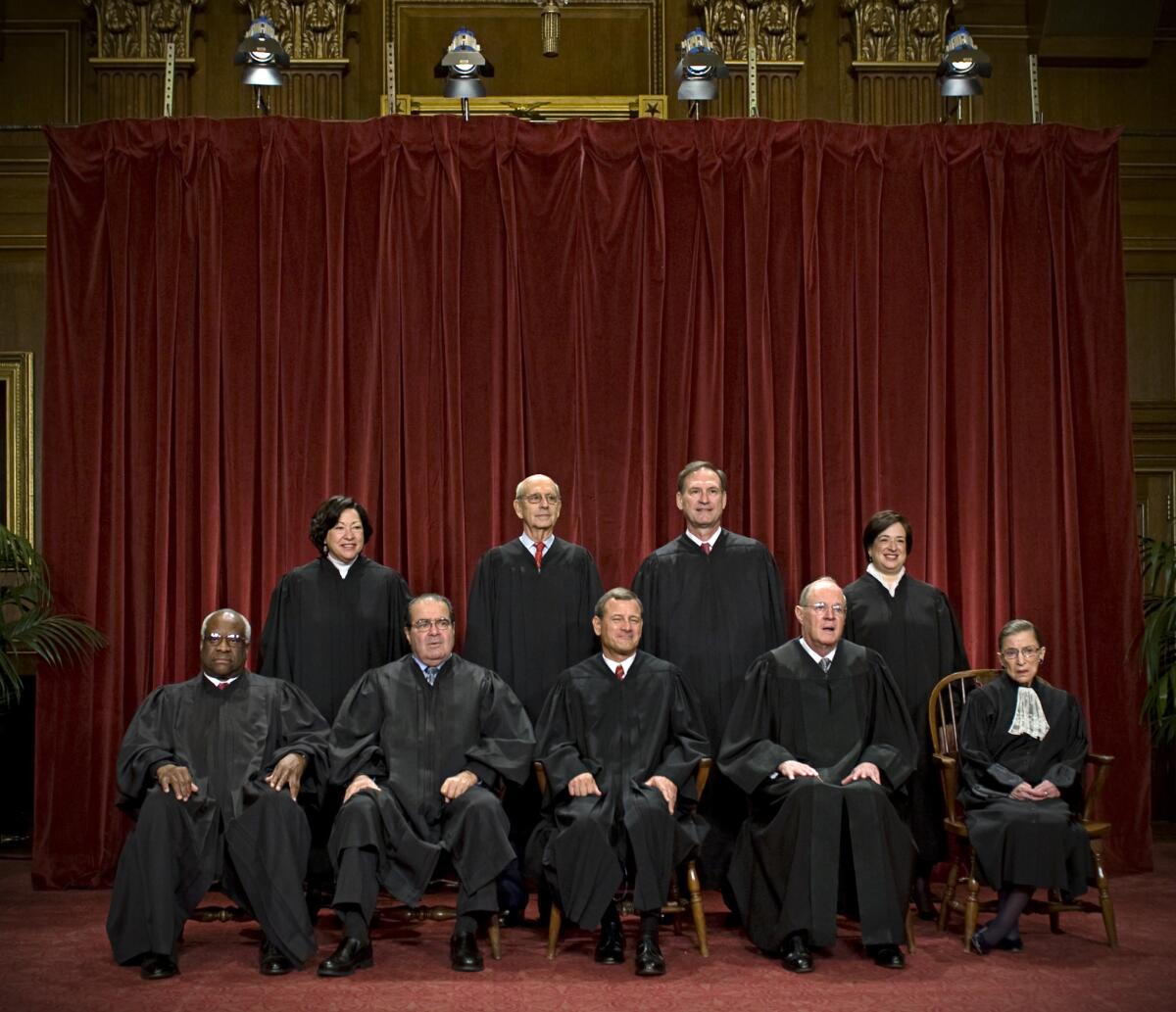Op-Ed: Putting Supreme Court justices out to pasture

The nine members of the Supreme Court pose for a group photograph in 2010.
In the third season of “House of Cards,” conniving President Frank Underwood colludes with U.S. Supreme Court Justice Robert Jacobs on the timing of Jacobs’ retirement. Their plan: to have the justice step down before his Alzheimer’s disease becomes perceptible and before Underwood leaves office, but only after Underwood gets a controversial — and potentially unconstitutional — program up and running.
“House of Cards” is obviously fiction, but the scenario is plausible. There is a real risk that partisan politics could affect the timing of resignations, which is just one of several reasons why unlimited, unstructured Supreme Court terms don’t make sense.
Although the founders quite reasonably settled on lifetime appointments to shield justices from ever-shifting political winds, they did not anticipate just how long justices would sit on the bench. The average Supreme Court tenure has jumped from less than 15 years before 1970 to more than 26 years today, as average life expectancies have gone up and as presidents have looked to nominate younger justices.
Justice Clarence Thomas was 43 when he was confirmed in 1991. If he remains on the court until he is 90, the age at which Justice John Paul Stevens retired, he will have served 47 years — far too long for any one individual to influence so many high-stakes decisions. Recent nominees John G. Roberts Jr. and Elena Kagan were both only 50 at the time of their appointments.
Another problem is that vacancies and nominations occur sporadically and unpredictably. Richard Nixon had four vacancies to fill in his first two years as president, while Jimmy Carter had none in his four years.
Finally, lifetime appointments may encourage justices to game the timing of their retirements, as in “House of Cards.” Some commentators have called on Justice Ruth Bader Ginsburg to retire, not because she has already served on the high court for 22 years, or because she is 82 years old, but because, as was recently noted in the New Republic, “she is currently serving in the sixth year of a Democratic presidential term, with no guarantee of who the next president will be” — a naked partisan appeal.
If lifetime appointments are a bad idea, what’s a better one? Standardized, 18-year, nonrenewable terms for Supreme Court justices would be ideal.
Even the most ardent defenders of extended tenures on the high court should be satisfied with 18 long years on the bench.
And because there are nine justices, appointments could — in time — be spaced out evenly: one every two years. This change would lower the temperature of confirmation hearings and end the possibility that one president would get to appoint almost half the court, with the next appointing no one.
American voters are increasingly wary of the Supreme Court. In 2000, a Gallup poll found that just 29% of Americans disapproved of the way the court was handling its job. In 2014, 48% disapproved.
Another poll, commissioned by an advocacy organization I run called Fix the Court, suggests why Americans are displeased. Harstad Strategic Research found that 3 in 4 respondents — all primary voters — think the court is doing a poor job of staying independent from politics. Two-thirds, including clear majorities from both parties, support 18-year standard terms for justices.
Switching to a new system would take time, but there are steps we can take now, such as calling for the next high court nominee to pledge to serve a single 18-year term. A voluntary pledge would bring needed attention to the issue and have an immediate effect on the culture of the court — an important moment for a body that respects precedent.
Although we haven’t made a significant change to the high court since 1869 — when we decided that nine was the number of justices that should sit on the bench — the United States has a proud tradition of scrutinizing old institutions and making the necessary changes to ensure that all parts of government uphold democratic principles.
Future nominees who agree to serve a single term of 18 years would be demonstrating to the American people their commitment to moving the Supreme Court forward and to making the institution more independent from partisan politics.
Gabe Roth is executive director of Fix the Court, a national nonprofit that advocates for a more open and accountable U.S. Supreme Court
Follow the Opinion section on Twitter @latimesopinion and Facebook
More to Read
A cure for the common opinion
Get thought-provoking perspectives with our weekly newsletter.
You may occasionally receive promotional content from the Los Angeles Times.










